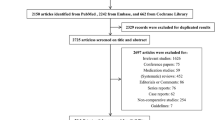Abstract
Objectives
To compare the outcomes of shock wave lithotripsy (SWL), percutaneous nephrolithotomy (PNL), and retrograde intrarenal surgery (RIRS) for 10–20 mm radiolucent renal calculi by evaluating stone-free rates and associated complications.
Patients and methods
A total of 437 patients at 7 institutions who underwent SWL (n = 251), PNL (n = 140), or RIRS (n = 46) were enrolled in our study. Clinical success was defined as stone-free status or asymptomatic insignificant residual fragments <3 mm. The success rates, auxiliary procedures, and complications were compared in each group.
Results
Success rates were 66.5, 91.4, and 87 % for SWL, PNL, and RIRS (p < 0.001). The need for auxiliary procedures was more common after SWL than PNL and RIRS (21.9 vs 5.7 vs 8.7 %, respectively; p < 0.001). The overall complication rates for the SWL, PNL, and RIRS were 7.6, 22.1, and 10.9 %, respectively (p < 0.001). Thirteen patients in PNL group received blood transfusions, while none of the patients in RIRS and SWL groups transfused. Hospitalization time per patient was 1.3 ± 0.5 days in the RIRS group, while it was 2.6 ± 0.9 days in the PNL group (p < 0.001). Fluoroscopy and operation time were significantly longer in the PNL group compared to RIRS (145.7 ± 101.7 vs 28.7 ± 18.7 s, and 57.5 ± 22.1 vs 43.1 ± 17 min, respectively).
Conclusions
For treatment of moderate-sized radiolucent renal stones, RIRS and PNL provide significantly higher success and lower retreatment rate compared with SWL. Although PNL is effective, its biggest drawback is its invasiveness. Blood loss, radiation exposure, hospital stay, and morbidities of PNL can be significantly reduced with RIRS technique.

Similar content being viewed by others
References
Türk C, Knoll T, Petrik A et al (2012) Guidelines on urolithiasis, pp 1–102. Available at: http://www.uroweb.org/gls/pdf/20_Urolithiasis.pdf
Michel MS, Trojan L, Rassweiler JJ (2007) Complications in percutaneous nephrolithotomy. Eur Urol 51:899–906
Deem S, Defade B, Modak A et al (2011) Percutaneous nephrolithotomy versus extracorporeal shock wave lithotripsy for moderate sized kidney stones. Urology 78:439–443
Wiesenthal JD, Ghiculete D, D’A Honey RJ et al (2011) A comparison of treatment modalities for renal calculi between 100 and 300 mm2: are shockwave lithotripsy, ureteroscopy and percutaneous nephrolithotomy equivalent? J Endourol 25:481–485
Bozkurt OF, Resorlu B, Yildiz Y et al (2011) Retrograde intrarenal surgery versus percutaneous nephrolithotomy in the management of lower-pole renal stones with a diameter of 15 to 20 mm. J Endourol 25:1131–1135
Preminger GM, Tiselius HG, Assimos DG et al (2007) 2007 guideline for the management of ureteral calculi. J Urol 178:2418–2434
Kanao K, Nakashima J, Nakagawa K et al (2006) Preoperative nomograms for predicting stone-free rate after extracorporeal shock wave lithotripsy. J Urol 176:1453–1456
Lingeman JE, Siegel YI, Steele B et al (1994) Management of lower pole nephrolithiasis: a critical analysis. J Urol 151:663–667
Sampaio FJ, Aragao AH (1992) Inferior pole collecting system anatomy: its probable role in extracorporeal shock wave lithotripsy. J Urol 147:322–324
Wang LJ, Wong YC, Chuang CK et al (2005) Predictions of outcomes of renal stones after extracorporeal shock wave lithotripsy from stone characteristics determined by unenhanced helical computed tomography: a multivariate analysis. Eur Radiol 15:2238–2243
Al-Ansari A, As-Sadiq K, Al-Said S et al (2006) Prognostic factors of success of extracorporeal shock wave lithotripsy (ESWL) in the treatment of renal stones. Int Urol Nephrol 38:63–67
Elkoushy MA, Hassan JA, Morehouse DD et al (2011) Factors determining stone-free rate in shock wave lithotripsy using standard focus of storz modulith SLX-F2 lithotripter. Urology 78:759–763
Weld KJ, Montiglio C, Morris MS et al (2007) Shock wave lithotripsy success for renal Stones based on patient and stone computed tomography characteristics. Urology 70:1043–1046
Wiesenthal JD, Ghiculete D, Honey RJ et al (2010) Evaluating the importance of mean stone density and skin-to-stone distance in predicting successful shock wave lithotripsy of renal and ureteric calculi. Urol Res 38:307–313
Abe T, Akakura K, Kawaguchi M et al (2005) Outcomes of shock wave lithotripsy for upper urinary-tract stones: a large scale study at a single institution. J Endourol 19:768–773
Unsal A, Resorlu B, Atmaca AF et al (2012) Prediction of morbidity and mortality after percutaneous nephrolithotomy by using the charlson comorbidity index. Urology 79:55–60
Albala DM, Assimos DG, Clayman RV et al (2001) Lower pole I: a prospective randomized trial of extracorporeal shock wave lithotripsy and percutaneous nephrostolithotomy for lower pole nephrolithiasis initial results. J Urol 166:2072–2080
Unsal A, Resorlu B, Kara C et al (2010) Safety and efficacy of percutaneous nephrolithotomy in infants, preschool age, and older children with different sizes of instruments. Urology 76:247–252
Tefekli A, Ali Karadag M, Tepeler K et al (2008) Classification of percutaneous nephrolithotomy complications using the modified Clavien grading system: looking for a standard. Eur Urol 53:184–190
De la Rosette JJ, Zuazu JR, Tsakiris P et al (2008) Prognostic factors and percutaneous nephrolithotomy morbidity: a multivariate analysis of a contemporary series using the Clavien classification. J Urol 180:2489–2493
Resorlu B, Oguz U, Resorlu EB et al (2012) The impact of pelvicaliceal anatomy on the success of retrograde intrarenal surgery in patients with lower pole renal stones. Urology 79:61–66
Conflict of interest
We have no conflict of interest.
Author information
Authors and Affiliations
Corresponding author
Rights and permissions
About this article
Cite this article
Resorlu, B., Unsal, A., Ziypak, T. et al. Comparison of retrograde intrarenal surgery, shockwave lithotripsy, and percutaneous nephrolithotomy for treatment of medium-sized radiolucent renal stones. World J Urol 31, 1581–1586 (2013). https://doi.org/10.1007/s00345-012-0991-1
Received:
Accepted:
Published:
Issue Date:
DOI: https://doi.org/10.1007/s00345-012-0991-1




